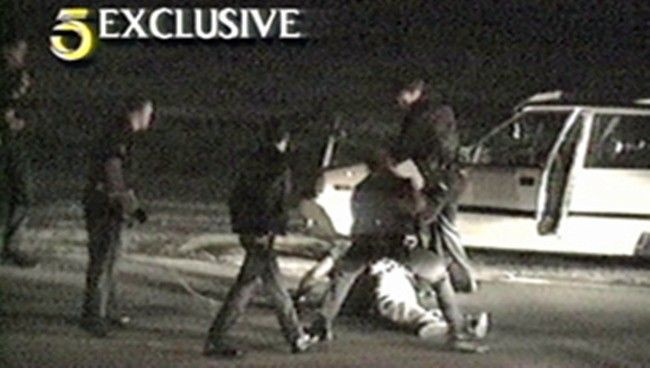The Rodney King Beating 20 Years Later - Its Impact on LAPD
Beating caught on video triggered debate on racism and police brutality. An investigation of the LAPD opened the way for closer civilian supervision.

A beating by Los Angeles police of motorist Rodney King was caught on video by an apartment dweller just across the road on March 3, 1991.
George Holliday, an Argentine plumber who captured the images on a Sony Handycam said the beating was so loud and raucous that it caught his attention, according to his website.
Video of the beating aired locally on TV station KTLA, who paid Holliday $500 for the rights to air it. Holliday says he went to the news station after Los Angeles police would not give him details about what happened.
The grainy video, which looks almost black and white and is out of focus in part, then spread nationally and internationally in the subsequent days and weeks, sparking a debate on race and police brutality.
In the video, King, who is black, is seen on the ground and attempting to stand up as white officers wielding batons beat him repeatedly. Numerous blows by are seen in the video itself. Wires from an electroshock weapon known as a Taser are seen dangling from King's body as well.
The video triggered internal and external investigations into the incident itself and the police department.
In July of 1991, an independent commission led by attorney Warren Christopher, who later became U.S. Secretary of State, was released. It covered five years of internal use of force reports from the police department.
The report covering 1986 to 1990 found a significant number of officers in the LAPD who repetitively use excessive force against the public, failure to control them by management and Department leadership. It recommended new standards of accountability.
According to the report, forty-four officers with six complaints or more alleging excessive use of force had received positive performance evaluations. A total of 183 officers had four or more allegations. There were 1,800 officers with at least one allegation.
Four police officers were brought to trial over the incident. A verdict on April 29, 1992 resulted in their acquittal.
The same day, riots began in the South Central Los Angeles area. As riots continued, then Gov. Pete Wilson made a request to the federal government to deploy the National Guard on city streets to restore order. The riots officially lasted six days and killed 53 people, caused numerous injuries and over $1 billion in property damage.
In June of 1992, LAPD police chief Daryl gates resigned after 14 years in the Department's top job amid pressure for him to leave.
One of the people who urged change in the wake of the beatings was John Mack, the current President of the city's Police Commission. At the time of the beating, he was the head of the Los Angeles Urban League.
The beating of Rodney King documented what so many members of the African-American community had known about all along, he told the Los Angeles Wave. He said his organization and others had received numerous complaints about police brutality, excessive use of force and racist practices.
But that video provided concrete evidence that members of the White community were able to see for the first time - an example of the kind of abuse that we had known, and so many members of our community had seen, he said.
As a result, the police department instituted term limits on future police chiefs and a civilian review board.
Current LAPD chief Charlie Beck said the incident changed the department in a big way.
I don't think there's any other incident in modern times that certainly changed the Police Department and changed the city to the extent that the King incident did, he told the Contra Costa Times.
We're still responding to things that were put in place by the Christopher Commission, their recommendations , the inspector general, the role of the police commission, even to the way I act as chief trying to be a nonpolitical chief. All that traces its way back to Rodney King.
© Copyright IBTimes 2024. All rights reserved.





















